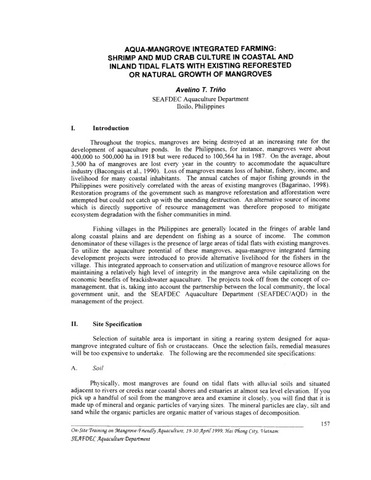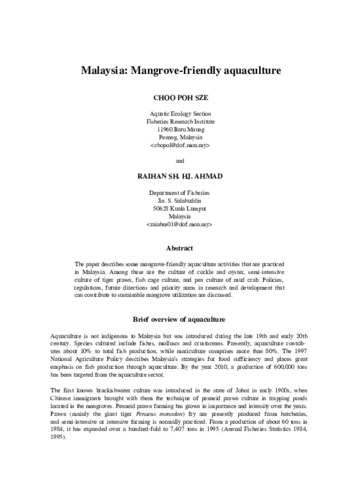Financial feasibility of green-water shrimp farming associated with mangrove compared to extensive shrimp culture in the Mahakam Delta, Indonesia
| dc.contributor.author | Bosma, Roel H. | |
| dc.contributor.author | Tendencia, Eleonor | |
| dc.contributor.author | Bunting, Stuart W. | |
| dc.date.accessioned | 2015-04-09T10:43:24Z | |
| dc.date.available | 2015-04-09T10:43:24Z | |
| dc.date.issued | 2012 | |
| dc.identifier.citation | Bosma, R. H., Tendencia, E. A., & Bunting, S. W. (2012). Financial feasibility of green-water shrimp farming associated with mangrove compared to extensive shrimp culture in the Mahakam Delta, Indonesia. Asian Fisheries Science, 25(3), 258-269. | en |
| dc.identifier.issn | 0116-6514 | |
| dc.identifier.uri | http://hdl.handle.net/10862/2170 | |
| dc.description | Paper presented at the 9th Asian Fisheries and Aquaculture Forum April 21-25, 2011, Shanghai, China | en |
| dc.description.abstract | This paper presents a post-hoc assessment of the introduction of intensive shrimp farming strategies, with and without green-water (GW) technology, in the Mahakam Delta where extensive systems (ES) dominate. The study also assesses the potential of integrated mangrove GW shrimp production (MGW). The method section describes the systems considered, the cost-benefit analysis applied and the assumptions for different scenarios. The data for the GW and non-GW systems were based on a survey in the Philippines. Assessing cultured shrimp yields from the total farm area showed that production from non-GW was 10% higher than from GW farms. Compared to these two systems, the MGW system produces about 20% of the total shrimp, but provides complementary livelihood options and ecosystem services. Per unit area covered, MGW system produces 20 times more shrimp than ES, while income for farmers doubles and opportunities for livelihoods enhancement associated with the mangrove area increase. Low operating costs make the ES interesting for resource poor farmers, but risks to producers and societal cost are underrated. Transferring from ES to MGW system will increase the contribution to the national economy whilst maintaining ecosystem services, that would otherwise be lost, were intensive culture systems to predominate. | en |
| dc.description.sponsorship | Preparation of this paper was supported by the MANGROVE project which received research funding from the European Community’s Sixth Framework Programme [Contract: INCO-CT-2005-003697], and from the RESCOPAR project funded by the INREF programme of Wageningen University. This publication reflects the authors’ views and the European Community is not liable for any use that may be made of the information contained herein. | en |
| dc.language.iso | en | en |
| dc.publisher | Asian Fisheries Society | en |
| dc.subject | Indonesia | en |
| dc.title | Financial feasibility of green-water shrimp farming associated with mangrove compared to extensive shrimp culture in the Mahakam Delta, Indonesia | en |
| dc.type | Article | en |
| dc.citation.volume | 25 | |
| dc.citation.issue | 3 | |
| dc.citation.spage | 258 | |
| dc.citation.epage | 269 | |
| dc.citation.journalTitle | Asian Fisheries Science | en |
| dc.subject.asfa | mangroves | en |
| dc.subject.asfa | shrimp culture | en |
| dc.subject.asfa | mangrove swamps | en |
| dc.subject.asfa | sustainable development | en |
| dc.subject.asfa | economic benefits | en |
| dc.subject.asfa | aquaculture | en |
| dc.subject.asfa | aquaculture economics | en |
| dc.subject.asfa | deltas | en |
このアイテムのファイル
| ファイル | サイズ | フォーマット | 閲覧 |
|---|---|---|---|
|
このアイテムに関連するファイルは存在しません。 |
|||
このアイテムは次のコレクションに所属しています
-
Journal Articles [1258]
These papers were contributed by Department staff to various national and international journals.



